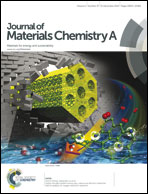Heterostructured composites consisting of In2O3 nanorods and reduced graphene oxide with enhanced interfacial electron transfer and photocatalytic performance
Abstract
A novel composite of In2O3 nanorods (INR) hybridized with reduced graphene oxide (RGO) was fabricated by a facile UV-assisted photoreduction method. The as-prepared samples were systematically characterized by X-ray diffraction, scanning electron microscopy, transmission electron microscopy, Raman spectroscopy, X-ray photoelectron spectroscopy and UV-vis diffuse reflectance spectroscopy. The one-dimensional INR with high surface-to-volume ratio anchored on the surface of RGO homogeneously, resulting in a nice interfacial contact between INR and RGO. The photocatalytic activities of the INR–RGO composites were investigated for 4-chlorophenol (4-CP) degradation under UV-vis or visible light irradiation. The photodegradation yield of the optimized photocatalyst reached 91.6%, which was about 1.9 times as high as that of INR under visible light irradiation (>400 nm). The enhanced photocatalytic activity of the INR–RGO composites can be ascribed to the efficient interfacial charge transfer from INR to RGO, which resulted in the prolonged lifetime of the photoinduced charge carriers.


 Please wait while we load your content...
Please wait while we load your content...